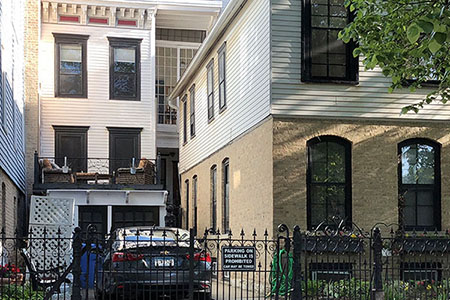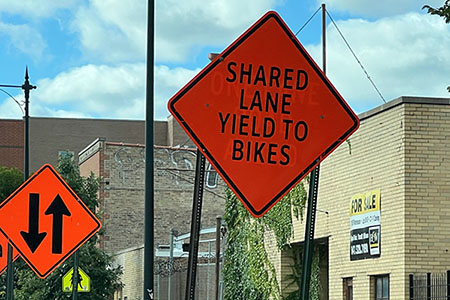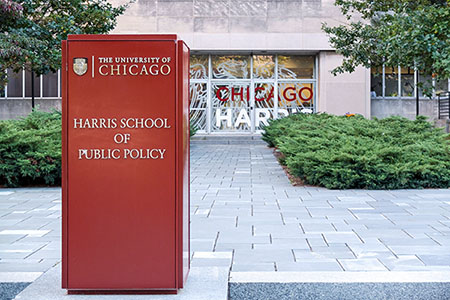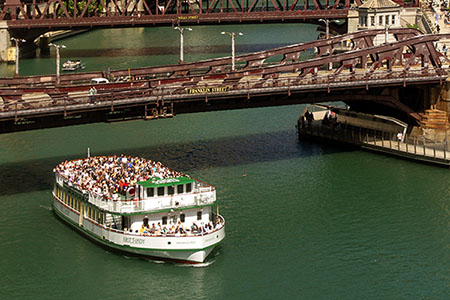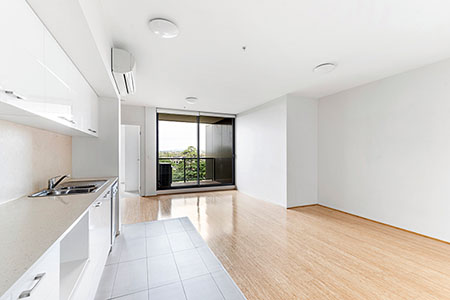(Above) Seen from the State Street Bridge on August 7, workers meet on a construction barge at right while building the Chicago Riverwalk. (Click on images to view larger versions.) Riverwalk construction eight weeks behind schedule
Sep. 12, 2014 – The full cost of the delays is still being calculated but construction of the Chicago Riverwalk is nearly eight weeks behind schedule, according to the project’s architect. City officials refuse to comment but have acknowledged minor delays throughout the year.
“We’re just uncertain when we’ll get the plantings in,” she says. “Ideally, we’d do that in the fall. But right now that’s on the table as to how delayed are we.”
Work below three bridges that was originally to begin in mid-April was first rescheduled to mid-May but did not start until mid-June. In May, debris at the bottom of the river delayed, for about three weeks, installation of the first caissons. Although heavy rain on June 30 caused no significant damage, the flooding did interrupt work, said CDOT, and they would have to make up for lost time. Early in the morning on July 10, a floating construction barge took on water and slowly sunk to the bottom of the Chicago River. On the barge was a JLG 600S telescopic boom lift that weighed 21,800 pounds, had a 40-gallon fuel tank, and was a total loss of about $104,000. The lift was recovered on July 16 and the barge five days later. (Below) A damaged boom lift is set down on a barge after being recovered from the Chicago River west of the Clark Street Bridge on July 16. City not borrowing the full $99 million And there is more. On June 13, Mayor Rahm Emanuel announced Chicago had been approved for a $99 million loan to keep building the Riverwalk but the city has not borrowed the full amount. Barney estimates the amount is less than $80 million. The money comes from the Transportation Infrastructure Finance Innovation Act, a program that provides federal assistance for infrastructure projects across the nation. The Chicago Riverwalk is the program’s first project. Michelle Woods, formerly CDOT’s project manager for the Riverwalk and now a project manager at the city’s Department of Fleet and Facility Management, did not respond to a request for the exact amount borrowed and why the amount is less than $99 million. Less money means less design. According to Barney, construction of the Riverwalk near the confluence, where the main branch splits into the north and south branches, “will not be as elaborate as originally planned.” Riverwalk management proposals due this month By the end of this year, the city hopes to have hired a company to develop and operate the entire Riverwalk. Working for the Department of Fleet and Facility Management – “2FM” for short – the Riverwalk manager will be responsible for planning, maintenance, and day-to-day operations. A Request for Proposals was issued on May 2 and they are due on September 30. The city is telling prospective managers that an estimated 100,000 square feet can be developed to bring in $3 billion over the next 35 years. Suggested uses for the new Riverwalk include stores, restaurants, coffee shops, bakery, concerts, theater, event space, and boat docks. (Above) A vision by VIATechnik, LLC, a Chicago firm that provides project administration services, of the Riverwalk east of LaSalle Street, with food vendors in spaces under Wacker Drive. (Below) East of Clark Street, with Venetian-inspired gondolas at right. The firm is also proposing live music venues, a fitness center, and a coffee bar with its own library. Although she has not seen any of the proposals, Barney has her own suggestions. “I always thought that this would be a good opportunity to do some retail or commercial on barges. It could be restaurants. It could be recreation, like swimming pools.” If the United States Army Corps of Engineers approved such a barge, the City of Chicago would benefit, she says, from being able to charge rent to the floating business without being responsible for its expenses. If a business did not work out, the city would not renew its lease. Another idea is to not develop the Riverwalk commercially, keep it as more of a greenway, and make nearby businesses, such as hotels, pay for it through a special tax assessment. “I think it’s going to cause a lot of economic growth and benefit to the adjacent property owners,” says Barney. The idea is not unprecedented. Tour boat operators have seen their dock fees on the Chicago River spike sharply this year, with the money going to a trust that was set up to help pay for Riverwalk construction. Barney notes difficulty Trump International Hotel & Tower has had with leasing its commercial space on its privately owned Riverwalk on the north bank of the Chicago River. But if the city’s new public Riverwalk attracts as many people as the existing walkway east of State Street, “I think they’d have a much better chance.” Says Barney, “I’d like to see the people who benefit from the improvement pay for it.”
|











